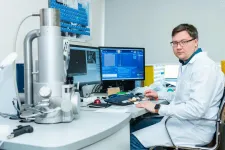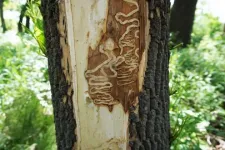How a receptor shapes the immune response
2021-03-10
(Press-News.org) Immune cells specialize to ensure the most efficient defense against viruses and other pathogens. Researchers at the University of Basel have shed light on this specialization of T cells and shown that it occurs differently in the context of an acute and a chronic infection. This could be relevant for new approaches against chronic viral infections.
Researchers led by Professor Carolyn King of the University of Basel have developed a method to study the specialization of T cells in the context of infections. In the journal eLife, they report the different directions this specialization takes, depending on whether it happens in the context of an acute viral infection such as influenza or a chronic one such as HIV infection or malaria, which can no longer be overcome by the body.
The study focused on so-called T-helper cells. When such a cell is activated by a viral infection, it can specialize in one of two ways: into a Th1 cell, which drives a more inflammation-heavy T killer cell response, or into a T follicular helper (Tfh) cell, which primarily supports antibody production. The balance between Th1 and Tfh cells therefore has important implications for how inflammatory the body's immune response is.
However, there are still gaps in our knowledge of how exactly a T helper cell decides which path to take when specializing. One factor that may play an important role is how strongly the T helper cell is activated - or, more precisely, its T cell receptor. The T-cell receptor is a kind of molecular sensor on the surface of the cell that more or less matches a part of the pathogen. The better they match, the more the receptor is activated.
Until now, however, it has not been possible to study the role of T-cell receptor signaling strength in the context of viral infections because researchers lacked a suitable experimental model. King and her team have now been able to develop one (see box) in collaboration with the research group of Professor Daniel Pinschewer, like King at the Department of Biomedicine.
The results of their analysis surprised the researchers: T-cell receptor activation does play a role, but an opposing one, depending on whether the infection was acute or chronic. Strong activation led to more inflammatory Th1 cells in acute viral infection. However, in chronic infection, strong activation produced more non-inflammatory Tfh cells.
"The reason behind this could be an evolutionary adaptation of nature to protect its own body," explains Dr. Marco Künzli, first author of the study. "If too many inflammatory Th1 cells are produced for too long during chronic infections, this would harm the body's own organs in the long run."
The experiments also yielded another interesting finding: Th1 cells that form as a result of weak activation could remain functional longer in chronic infection than if their specialization was triggered by strong activation of the receptor. This is relevant because Th1 cells "fatigue" over time in chronic infections.
"Our results add a piece to the puzzle of T cell exhaustion and might - as a first step - contribute to new approaches in treating chronic viral infections," King summarizes the significance of the findings.
Context box: Measuring the fate of T cells
For their new method, the research group relied on mice with T helper cells that all carry the same receptor, which recognizes a specific virus (lymphocytic choriomeningitis virus, or LCMV). The researchers specifically mutated this LCMV to activate the T cell receptor strongly, at an intermediate level or only weakly. In addition, there are two minimally different types of LCMV, one leading to acute infections and the other leading to chronic infections. Thus, the researchers were able to infect the mice with the different virus variants and study the further development of the T cells in their blood - on the one hand in the context of an acute, on the other hand in the context of a chronic virus infection.
INFORMATION:
ELSE PRESS RELEASES FROM THIS DATE:
2021-03-10
The scientists of the National University of Science and Technology "MISIS" (NUST MISIS) being a part of an international team of researches managed to increase the capacity and extend the service life of lithium-ion batteries. According to the researchers, they have synthesized a new nanomaterial that can replace low-efficiency graphite used in lithium-ion batteries today. The results of the research are published in the Journal of Alloys and Compounds.
Lithium-ion batteries are widely used for household appliances from smartphones to electric vehicles. The charge-discharge cycle in such battery is provided by ...
2021-03-10
As plastic debris weathers in aquatic environments, it can shed tiny nanoplastics. Although scientists have a good understanding of how these particles form, they still don't have a good grasp of where all the fragments end up. Now, researchers reporting in ACS' Environmental Science & Technology have shown experimentally that most nanoplastics in estuarine waters can clump, forming larger clusters that either settle or stick to solid objects, instead of floating on into the ocean.
There is a huge discrepancy between the millions of tons of plastic waste entering rivers and streams and the amount researchers have found in the oceans. As large pieces of plastic break apart into ...
2021-03-10
The mosquito protein AEG12 strongly inhibits the family of viruses that cause yellow fever, dengue, West Nile, and Zika and weakly inhibits coronaviruses, according to scientists at the National Institutes of Health (NIH) and their collaborators. The researchers found that AEG12 works by destabilizing the viral envelope, breaking its protective covering. Although the protein does not affect viruses that do not have an envelope, such as those that cause pink eye and bladder infections, the findings could lead to therapeutics against viruses that affect millions of people around the world. The research ...
2021-03-10
Throughout history, leather has been a popular material for clothes and many other goods. However, the tanning process and use of livestock mean that it has a large environmental footprint, leading consumers and manufacturers alike to seek out alternatives. An article in Chemical & Engineering News (C&EN), the weekly newsmagazine of the American Chemical Society, details how sustainable materials are giving traditional leather a run for its money.
Traditional leather goods are known for their durability, flexibility and attractive finish, with a global market worth billions, writes ...
2021-03-10
Since its introduction, the emerald ash borer (EAB) has become the most devastating invasive forest insect in the United States, killing hundreds of millions of ash trees at a cost of hundreds of millions of dollars.
Now, new research from the University of Minnesota's Minnesota Invasive Terrestrial Plants and Pests Center (MITPPC) shows a possible path forward in controlling the invasive pest that threatens Minnesota's nearly one billion ash trees.
In a recent study published in Fungal Biology, MITPPC researchers identified various fungi living in EAB-infested trees -- a critical ...
2021-03-10
Energy-efficient light-emitting diodes (LEDs) have been used in our everyday life for many decades. But the quest for better LEDs, offering both lower costs and brighter colours, has recently drawn scientists to a material called perovskite. A recent joint-research project co-led by the scientist from City University of Hong Kong (CityU) has now developed a 2D perovskite material for the most efficient LEDs.
From household lighting to mobile phone displays, from pinpoint lighting needed for endoscopy procedures to light source to grow vegetables in Space, LEDs ...
2021-03-10
Hip fractures are serious, especially for the elderly. The operation can be a great strain, and 13 per cent of patients over the age of 70 do not survive 60 days after the fracture.
Their chance of survival may depend on how busy the surgeons are with other emergency procedures.
"When the operating room is busy, 20 per cent more of the patients die within 60 days after the operation," says Professor Johan Håkon Bjørngaard at the Norwegian University of Science and Technology's (NTNU) Department of Public Health and Nursing.
Surgeons can get especially busy during periods when the patient demand for surgery is high. In busy periods, hip fracture patients ...
2021-03-10
Bone is not just a fixed material - it's a dynamic set of structures that can adapt their mass and strength based on the loads they must support.
Developing that sort of adaptive material has long been the dream of scientists. Now for the first time, scientists at the Pritzker School of Molecular Engineering (PME) at the University of Chicago have developed a gel material that strengthens when exposed to vibration.
Not only were scientists able to make the material 66 times stronger through vibrations, they were also able to strengthen only the areas exposed to movement. That sort of specificity could lead to new adhesives and ...
2021-03-10
Scientists have developed a see-through glass display with a high white light contrast ratio that smoothly transitions between a broad spectrum of colors when electrically charged. The technology, from researchers at Jilin University in Changchun, China, overcomes limitations of existing electrochromic devices by harnessing interactions between metal ions and ligands, opening the door for numerous future applications. The work appears March 10 in the journal Chem.
"We believe that the method behind this see-through, non-emissive display may accelerate the development of transparent, eye-friendly displays with improved readability for bright working conditions," says Yu-Mo Zhang, an associate professor of chemistry at Jilin ...
2021-03-10
The cryptocurrency market has been abuzz as Bitcoin gains popularity with investors, reaching an all-time high of over $58,000 apiece in February. In a commentary published March 10 in the journal Joule, financial economist Alex de Vries quantifies how the surging Bitcoin price is driving increasing energy consumption, exacerbating the global shortage of chips, and even threatening international safety.
Theoretically, any computer with access to the internet and electricity can "mine" Bitcoin, a process to receive cryptocurrency by solving sophisticated mathematical equations. It is estimated that all miners combined make over 150 quintillion--that is 18 zeros following 150--attempts every second to solve the equation, according to numbers from January 11, 2021. Computational power ...
LAST 30 PRESS RELEASES:
[Press-News.org] How a receptor shapes the immune response



